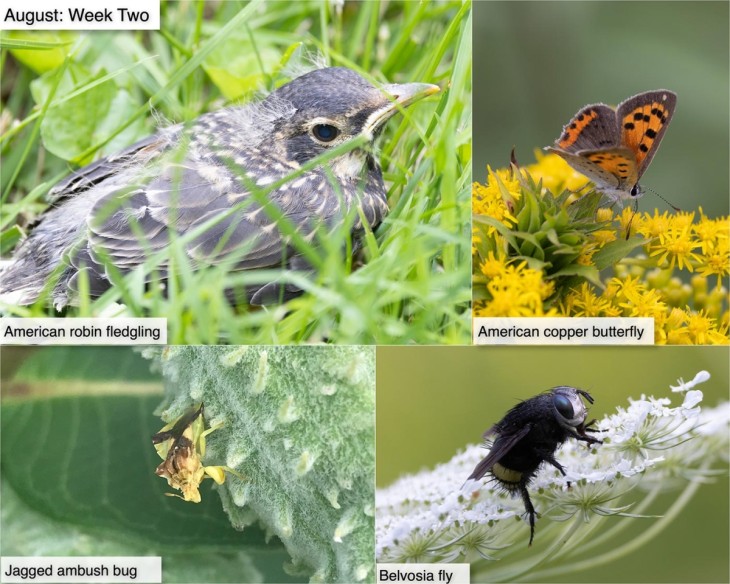This week in the woods, we observed an American robin chick making its first wobbly flight from the nest, which started off well but ended with a crash landing on the lawn. (The young bird was fine, and soon made its second flight, which seemed to go much better.) We’ve been observing this robin and its siblings since we first noticed their tiny heads popping up from a nest over a shed door, about two weeks ago. All told, the time from hatching to flight required about 15 days. Robins are big, bold members of the thrush family, and in common with their daintier bluebird cousins, can produce multiple broods in a summer.
You can find American coppers from late spring through summer, but their population peaks in August, when you’ll often see them nectaring on goldenrod. Their caterpillar host plants include species in the Rumex (buckwheat) family, including non-native curly dock, a common plant in fields and meadows. As noted in the Vermont Center for Ecostudies’ Vermont Butterfly Atlas, this species may not be native to North America, and likely hitched a ride here with European settlers.
Belvosia flies are also out in droves. These bristle flies are tachinid flies, and their larvae often prey on the caterpillars and pupae of sphinx moths. As you can see from the photo, this fly (probably B. borealis) is a bee mimic. Belvosia flies are harmless to people, but the combination of a spiky, yellow striped back end and pale fright mask face can make for an alarming first impression.
Finally, jagged ambush bugs are also lurking in goldenrod patches, although they’re very hard to find when they’re perched on the yellow blooms (this one considerately revealed itself by perching on a milkweed pod). They’re tiny, and blend in almost perfectly with goldenrod petals. As indicated by their name, ambush bugs remain perfectly still much of the time, waiting to pounce on (often, much larger) prey. Here’s an Outside Story article by Steven Shepard, which includes a wonderful close-up illustration by Adelaide Murphy Tyrol and this fun description of why ambush bugs are such effective predators:
If they were blown up to the size of a car, they would put a Bradley Fighting Vehicle to shame. Armored and massively muscular, they easily capture and overpower prey many times their own size.
What have you noticed in the woods this week? Submit a recent photo for possible inclusion in our monthly online Reader Photo Gallery.


